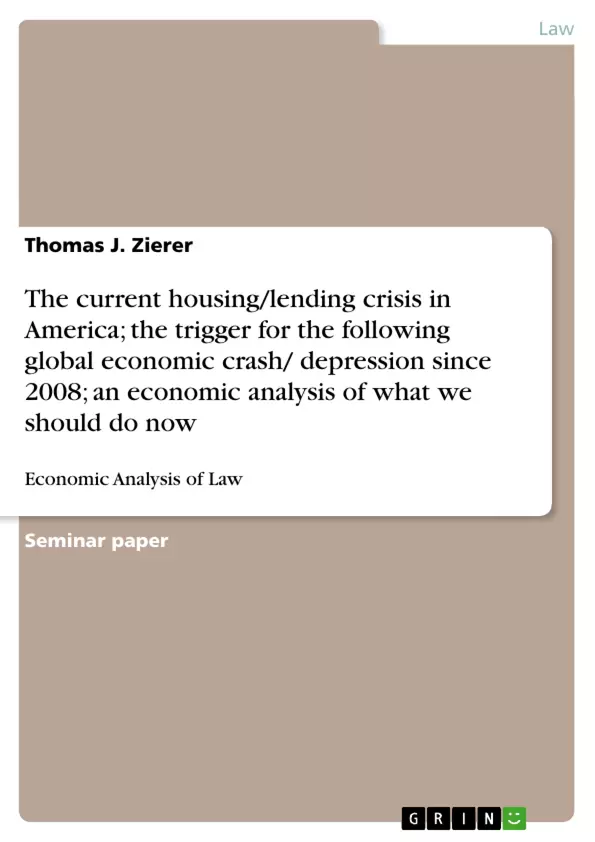The work is about the current subprime and financial crisis in Amerika being the trigger for the following global economic crash/depression since 2008. It answeres the questions on: why did it happen (and finally who is to be blamed for mostly); how it could have been averted; and what has to be done, in the predominant part concerning legislation, to averting such a disaster in the future.
A. Introduction
The question, on the current housing / lending crisis in America, what should we do now?, can only be answered when it is figured out why it got so far; in especially, why existing legislation did not work, what role predatory lending played and how far high finance on the secondary market, with Collateralized Debt Obligations ( CDOs ) and the selling /purchasing of so called high-risk junior tranches played a role, and last not least on this level: how it could have been possible, that almost an avalanche of class actions has been rolling over courts grounded on the alleged breaching of acts that were implemented straight on the experience of The Great Depression of the 1930´s; like Securities Exchange Commissions ( SEC ) Rule 10b-5, having its basis at least in the 1934 Exchange Act
Were "bad" subprime loans that were doomed from the beginning to default, given because of unscrupulous predatory lenders / loan brokers making immoral profits out of extremely high interest rates , so they are to be blamed.
Were states like Georgia (and Mew Mexico, New Jersey) forced, for these predatory lending methods, to implement borrowers protection acts, long before the crisis became vivid, like the 2001 Georgia Fair Lending Act (GFLA), but those efforts were stopped through the intervention of the Feds before the Officer of the Comptroller of the Currency (OCC) who pre-empted those laws as far as it was in conflict with federal banking law , making them that way worthless. Are the Feds and the OCC, and so far United States governmental institutions, to be blamed, for pre-empting laws that could have at least mitigated the effects of the crisis?
(...)
Inhaltsverzeichnis (Table of Contents)
- A) Introduction
- B) How could the housing crisis have happened? What solutions can be offered to prevent such a disaster in the future?
- I. The Borrowers-Loan Originators Level
- 1) The loan extension itself
- a) underwriting standards and fraud
- b) fraud
- 2) Adjustable Rate Mortgages (ARMs) and Predatory Lending
- a) ARM in general
- b) different kinds of ARMS
- c) Effects on the borrowers and how ARMS are used by lenders
- d) solution ARM-predatory lending, future prevention
- II. Governmental Level
- 1) What has already been done to prevent ongoing foreclosures or at least to mitigate the problem
- 2) Further legislation that has been brought on the way; HOPE FOR HOMEOWNERS ACT 2008
- III. The secondary market trading level
- 1) The process of securitization
- 2) credit enhancement
- 3) what went wrong on the secondary market (with due diligence)?
- 4) The meaning of the secondary market itself and predatory lending (facilitated by the secondary market)
- C) Final Conclusion
Zielsetzung und Themenschwerpunkte (Objectives and Key Themes)
This economic analysis aims to understand the causes of the American housing and lending crisis of 2008 and explore potential solutions to prevent future occurrences. It investigates the roles of various actors, from borrowers and lenders to government agencies and the secondary market.
- Underwriting standards and fraud in loan origination
- The role of adjustable-rate mortgages (ARMs) and predatory lending
- Governmental responses and legislation to mitigate the crisis
- The function of the secondary market and securitization in the crisis
- The impact of existing legislation and its shortcomings.
Zusammenfassung der Kapitel (Chapter Summaries)
A) Introduction: This section introduces the central question of the analysis: how to address the current housing and lending crisis. It highlights the need to understand the underlying causes, including the failure of existing legislation, the role of predatory lending, and the impact of high finance in the secondary market.
B) How could the housing crisis have happened? What solutions can be offered to prevent such a disaster in the future? This section delves into the factors contributing to the crisis, examining the crisis from the perspectives of borrowers, lenders, and government. It explores issues such as underwriting standards, fraud, adjustable-rate mortgages, and the role of governmental intervention. Specific proposals by various individuals and organizations are also examined.
I. The Borrowers-Loan Originators Level: This section analyzes the crisis from the perspective of borrowers and lenders. This includes an examination of loan extensions, underwriting standards, fraud, adjustable-rate mortgages (ARMs), and predatory lending practices.
II. Governmental Level: This section focuses on the government's role in the crisis, examining existing legislation and its effectiveness (or lack thereof) in preventing foreclosures and mitigating the problem. It also reviews proposed and implemented legislative solutions.
III. The secondary market trading level: This section examines the secondary market's role in the crisis, analyzing the processes of securitization, credit enhancement, and the failures of due diligence. It explores how the secondary market facilitated predatory lending.
Schlüsselwörter (Keywords)
Housing crisis, lending crisis, subprime loans, predatory lending, adjustable-rate mortgages (ARMs), securitization, underwriting standards, fraud, government regulation, Community Reinvestment Act (CRA), Home Mortgage Disclosure Act (HMDA), HOPE FOR HOMEOWNERS ACT 2008, secondary market, Collateralized Debt Obligations (CDOs), foreclosures.
- Quote paper
- Thomas J. Zierer (Author), 2008, The current housing/lending crisis in America; the trigger for the following global economic crash/ depression since 2008; an economic analysis of what we should do now, Munich, GRIN Verlag, https://www.grin.com/document/124495



